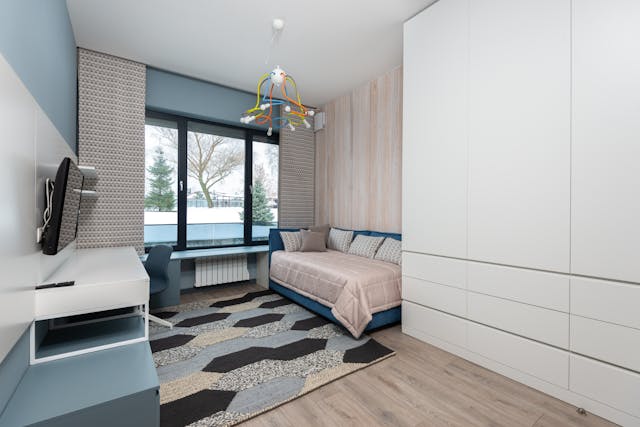Chennai’s charm lies in its rich cultural heritage, thriving arts scene, stunning coastline, and a tropical climate that feels like summer all year long. But while the city offers a vibrant lifestyle and scenic beauty, its climate brings a unique set of challenges for homeowners especially when it comes to interior design.
The combination of high humidity, salty sea breeze, intense heat, and seasonal monsoons can take a serious toll on your home. Materials that look perfect in a catalog like untreated wood, plush upholstery, or iron fixtures can warp, rust, or attract mold within months. Paint peels. Cabinets swell. Cushions smell musty. Suddenly, your dream interior becomes a high-maintenance nightmare.
That’s why interior designing in Chennai is not just about aesthetics, it’s about resilience. It’s about making thoughtful, climate-adapted choices that ensure your space remains beautiful, functional, and durable year-round. From selecting moisture-resistant materials to designing for airflow and sunlight, every decision counts.
This guide will help you make smart, climate-conscious design choices that reflect your personal style while standing up to Chennai’s coastal conditions.
The Reality of Living in Chennai’s Coastal Climate
Chennai’s coastal location brings with it a mix of natural beauty and harsh environmental conditions that directly impact how homes are designed and maintained. While the sea breeze offers relief on hot afternoons and the monsoons bring lush greenery, these same elements also pose long-term threats to your home’s interiors if not managed properly.
High humidity is a year-round concern. It encourages the growth of mold and mildew, especially in corners, wardrobes, behind furniture, and on fabric surfaces. Wooden doors, cabinets, and flooring are prone to swelling, making them difficult to open or close and shortening their lifespan.
Salt-laden air from the Bay of Bengal corrodes metal fittings, thick door handles, curtain rods, window frames, and even kitchen hardware. Over time, the fine salt particles settle on surfaces and accelerate wear and tear, leaving finishes dull and rust-prone.
Intense heat during Chennai’s long summers can cause wall paint to fade or peel, reduce the lifespan of adhesives, and make indoor spaces uncomfortably warm. Heat can also affect the durability of soft furnishings, especially synthetic ones, by weakening their fibers or causing discoloration.
Seasonal monsoons bring their own challenges. Inadequate drainage or poor-quality sealants can lead to water seepage, especially around windows, balconies, and basements. The aftermath often includes damp odors, fungus in wardrobes, and ruined storage if not managed proactively.
Living in Chennai means your home must work just as hard as you do. That’s why interior design here goes beyond looks; it’s about long-term durability, smart ventilation, and using materials that can handle the city’s tropical temperament. By understanding these climate factors early on, you can create a home that isn’t just visually stunning, but also weather-resilient and easy to maintain.
Climate-Resistant Materials: What to Use and What to Avoid
In a city like Chennai, where moisture and heat are daily realities, the materials you choose for your interiors can make or break your living experience. Investing in climate-resilient finishes not only improves comfort but also saves you from costly repairs and replacements down the line.
Wood: Regular plywood and untreated wood are vulnerable to swelling, cracking, and termites in Chennai’s humidity. Instead, opt for marine plywood, which is water-resistant and ideal for kitchen cabinets, wardrobes, and bathroom vanities. Teak is another excellent choice due to its natural oils that repel moisture and insects. Engineered wood is a budget-friendly alternative that resists warping better than solid wood.
Metals: Skip materials like iron or mild steel unless they are thoroughly treated or painted with anti-corrosive coatings. For long-term performance, powder-coated aluminum, stainless steel (Grade 304 or 316), and brass are much better suited for hardware, fixtures, and furniture frames. These materials stand up well to salty air and require less maintenance over time.
Flooring: Humidity can cause wooden floors to expand, buckle, or grow mold. Carpets, too, tend to trap moisture and dust, making them unhygienic in coastal climates. Instead, go for vitrified tiles, ceramic tiles, or natural stones like granite or Kota stone, all of which are durable, easy to clean, and resistant to moisture damage.
Fabrics: Soft furnishings can quickly become musty in humid weather. Natural fabrics like cotton, linen, and bamboo blends allow better air circulation and dry quickly making them ideal for curtains, bedsheets, and upholstery. Avoid heavy synthetic fabrics like polyester or velvet, which trap heat and moisture, leading to foul smells and quicker wear and tear.
Ultimately, interior designing in Chennai isn’t just about choosing what looks good, it’s about selecting materials that can breathe, resist corrosion, and handle temperature fluctuations. Prioritizing performance over trend ensures your home remains elegant, low-maintenance, and long-lasting no matter the weather outside.
Designing for Airflow: How to Keep Your Home Naturally Cool and Dry
In humid cities like Chennai, ventilation is everything. Stagnant air leads to musty smells, mildew, and an over-reliance on air-conditioners. By designing your home to promote natural airflow, you can enjoy a fresher indoor environment while lowering your energy consumption.
Smart Ventilation Strategies:
- Cross-Ventilation with Large Windows: Align windows on opposite walls to create a natural breeze pathway. Sliding or casement windows work best.
- Louvred Doors & Ventilated Cabinets: Use louvres in bathrooms, kitchens, and wardrobes to prevent moisture buildup.
- Ceiling Fans & Exhaust Fans: Ceiling fans circulate air in living spaces, while exhaust fans in kitchens and bathrooms expel humid air directly outdoors.
- Dehumidifiers for Closed Areas: In built-in wardrobes and storage spaces, mini-dehumidifiers or desiccant packs (like silica gel) help absorb excess moisture.
When airflow is part of the design not an afterthought Chennai home interiors will feel noticeably cooler and cleaner.
Light and Color: Creating a Bright, Breezy Interior Year-Round
Color plays a surprisingly big role in how a space feels visually and thermally. In Chennai’s warm coastal climate, the right palette can help reflect heat and create an airy, relaxed aesthetic.
Tips to Elevate Your Interior with Light:
- Go Light and Neutral: Shades like off-white, ivory, light grey, and sandy beige reflect sunlight and make spaces feel expansive.
- Coastal Tones for Calm: Soft blues and seafoam greens bring in coastal freshness and pair well with natural textures.
- Avoid Heat-Trapping Colors: Dark walls or black furnishings absorb heat, making interiors stuffier.
- Maximize Natural Light: Use sheer or linen curtains to let in daylight while maintaining privacy.
- Add Reflective Surfaces: Mirrors near windows amplify brightness and airflow visually.
- Layer Lighting Thoughtfully: During overcast monsoons, layer ambient and task lights to keep rooms well-lit without relying on harsh overhead lighting.
Choosing the right light and color scheme can turn even compact spaces into bright, uplifting sanctuaries.
Furniture and Decor That Works in Humid, Coastal Homes
In Chennai, where heat and humidity rule, furniture materials can either make or break your comfort. Instead of bulky, upholstered pieces that trap heat and absorb moisture, opt for breathable, low-maintenance alternatives.
Smart Coastal Furniture Choices:
- Go Natural with Rattan & Bamboo: These materials are naturally breathable, lightweight, and ideal for humid climates.
- Use Treated Wood or Powder-Coated Metals: These resist warping, corrosion, and termites—common coastal issues.
- Choose Washable Fabrics: Removable covers for cushions, sofas, and pillows allow easy cleaning during the sweaty or rainy seasons.
- Minimalist, Open Designs: Avoid heavy décor or cluttered furniture that traps moisture or dust.
You don’t have to sacrifice style, coastal-friendly furniture can be just as elegant as it is functional.
Moisture-Proofing Your Storage and Wall Finishes
Storage spaces are often the first to suffer in humid homes. Without proper protection, mold can creep into cabinets, and damp walls can ruin paint and structure.
Tips for Long-Lasting, Moisture-Resistant Interiors:
- Use Waterproof Laminates: Especially for kitchen cabinets, wardrobe interiors, and bathroom storage.
- Ventilation in Built-ins: Small vents or breathable mesh panels allow air circulation and prevent mold.
- Anti-Fungal Paint & Primer: For wall surfaces, especially near windows and bathrooms.
- Charcoal Bags or Silica Gel Packs: In wardrobes or shoe racks, they quietly absorb excess humidity.
- Elevated Storage Units: Keeping units slightly off the floor helps prevent water damage during floods or heavy rains.
When storage is designed with Chennai’s weather in mind, you’ll save time, money, and headaches in the long run.
Outdoor Spaces That Withstand Coastal Weather
Balconies and terraces offer a much-needed escape—but without proper planning, they can quickly become unusable during Chennai’s intense heat or monsoons.
Design Ideas for Year-Round Usability:
- Use Weather-Resistant Furniture: Opt for powder-coated metal, polyresin, or marine-grade teak that won’t warp or rust.
- Plant Salt-Tolerant Greenery: Palms, ferns, hibiscus, and succulents thrive in Chennai’s conditions with minimal fuss.
- Install Drainage-Friendly Flooring: Materials like interlocking deck tiles or anti-skid outdoor ceramics prevent water stagnation.
- Add Shade Elements: Pergolas, bamboo blinds, retractable awnings, or green roofs cool the space naturally.
- Create a Seamless Indoor-Outdoor Feel: Use similar colors or materials to connect your outdoor seating with your interior design.
With these tweaks, your outdoor areas will feel like natural extensions of your home usable, stylish, and weather-ready.
Sustainable Design for Coastal Living in Chennai
Designing with the planet in mind is no longer a luxury, it’s a necessity. Sustainable design not only benefits the environment but also enhances comfort and lowers long-term costs.
Eco-Friendly Solutions That Work for Chennai:
- Design for the Breeze: Orient living areas toward sea-facing directions to maximize natural airflow.
- Use Cool Roof Coatings: Reflective paints reduce indoor temperatures and extend your roof’s life.
- Incorporate Jalis or Cavity Walls: Traditional terracotta jalis provide shade while letting air pass through.
- Solar-Powered Fixtures: Chennai’s sunny days make it perfect for solar-powered lights, garden lamps, and fans.
- Harvest Rainwater: Set up basic filtration tanks to store rainwater from monsoons for garden or household use.
Sustainable doesn’t have to be complicated—it starts with smart choices aligned with the local climate.
Conclusion
Designing a home in Chennai isn’t just about choosing what looks good—it’s about creating spaces that feel good to live in, all year long. From maximizing airflow to selecting the right furniture, every detail of Chennai home interiors should reflect the unique rhythm and demands of coastal living.
But climate-conscious living doesn’t mean compromising on style. It means elevating your space with intention. With thoughtful choices in materials, layout, and color palette, your home can become a haven—cool, calm, and effortlessly inviting.
If you’re unsure how to bring these ideas into your existing home or a new build, the expert team at Tint Tone and Shade can guide you through every step. From functional layouts to timeless finishes, they specialize in designing homes that not only look beautiful but truly belong in Chennai’s climate.
Book a call today and start designing a home that works with the weather not against it.







